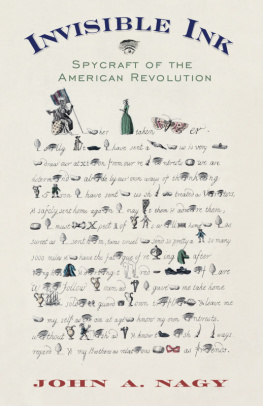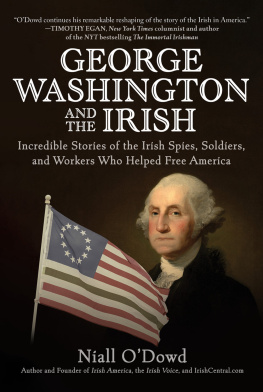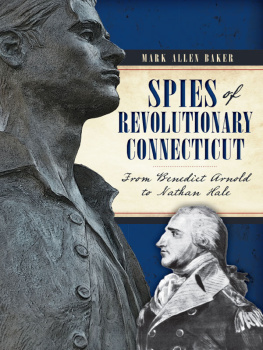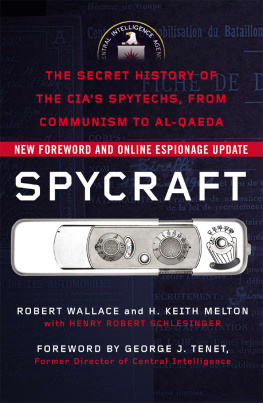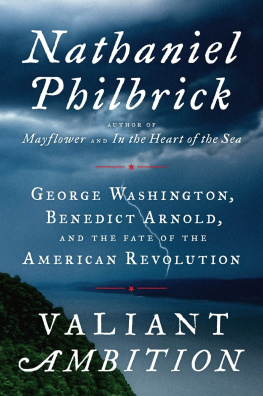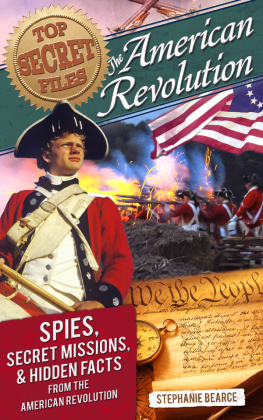Also by the Author
Rebellion in the Ranks: Mutinies of the American Revolution
Spies in the Continental Capital: Espionage Across Pennsylvania During the American Revolution
INVISIBLE INK
SPYCRAFT OF THE AMERICAN REVOLUTION

John A. Nagy
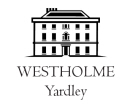
Copyright 2010 John A. Nagy
Maps by Tracy Dungan 2010 Westholme Publishing
All rights reserved under International and Pan-American Copyright Conventions. No part of this book may be reproduced in any form or by any electronic or mechanical means, including information storage and retrieval systems, without permission in writing from the publisher, except by a reviewer who may quote brief passages in a review.
Westholme Publishing, LLC
904 Edgewood Road
Yardley, Pennsylvania 19067
Visit our Web site at www.westholmepublishing.com
ISBN: 978-1-59416-523-8 (electronic)
Also available in paperback and hardback.
Produced in the United States of America.
Front: A rebus letter America to her Mistaken Mother, published by Mary Darly, London, May 11, 1778 (Library of Congress). In a rebus, small pictures replace letters in words making a puzzle for the reader to solve. It was a popular form of entertainment in the eighteenth century. This letter was written in response to another rebus letter entitled Britannia to America, a plea from Great Britain to America to reconsider its alliance with France and to accept the terms of peace that Britain sent to America with the Carlisle Commission. An Indian princess was commonly used in eighteenth-century prints to represent America. She is holding the new American flag and a fleur-de-lis which symbolizes France. The five children in the letter is a reference to the Carlisle Commissioners. The rebus reads:
(America) (toe) her (miss)taken (moth)er.
(Yew) s(eye)lly (old woman) t(hat) (yew) have sent a (lure) (toe) us is very (plain) (toe) draw our at(ten)t(eye)[attention] on from our re(awl) (eye)ntrests (butt) we are determ(eye)nd (toe) ab(eye)de by our own ways of the th(eye)nk(eye)ng [thinking]. (Ewer) (five) (child)ren (yew) have sent (toe) us sh(awl) (bee) treated as V(eye)s(eye)tors, & safely sent home aga(eye)n. (Yew) may (console)t them & adm(eye)re them, (butt) (yew) must (knot) (x)pect (one) of (ewer)(puppet)s w(eye)ll (comb) home (toe) (yew) as sweet as (yew) sent h(eye)m twas cruel (toe) send so pretty a (man) so many 1000 miles & (toe) have the fat(eye)gue of re(urn)ing (back) after (spike)(eye)ng h(eye)s (coat) & d(eye)rt(eye)ng [dirtying] t(hose) red (heel) (shoes). (Eye)f (yew) are w(eye)(eye) [wise] follow (ewer) own ad(vice) (yew) gave (toe) me take home (ewer) (ships) sold(eye)(ears) [soldiers] guard (well) (ewer) own tr(eye)fl(eye)(ling) [trifling] & leave me (toe) my self as (eye) am at age (toe) know my own (eye)ntrests. W(eye)thout (ewer) (fool)(eye)sh ad(vice) & know t(hat) (eye) sh(awl) (awl)ways regard (yew) & my Brothers as relat(eye)ons (butt) (knot) as fr(eye)ends.
(Eye) am (ever) (great)ly (eye)njured.
Daughter Amer(eye)k.
To Ida Marie Nagy, Jennifer Ann Nagy, and Lisa Marie Nagy, with thanks for your encouragement, help, and patience
To the memory of my sister Linda Susan Joan Nagy-Chizmarik
CONTENTS
List of Illustrations
INTRODUCTION
Knowledge of the spirit world is to be obtained by divination; information in natural science may be sought by inductive reasoning; the laws of the universe can be verified by mathematical calculation: but the dispositions of an enemy are ascertainable through spies and spies alone.Mei Yaoch`en, Chinese poet and military commentator, c. 1050 A.D.
The need to cultivate the use of spies and the information they acquire has been known throughout the ages. Sun Tzu, a great Chinese military general, wrote in the 6th century B.C. that to remain in ignorance of the enemys condition simply because one grudges the outlay of a hundred ounces of silver in honors and emoluments [for spies], is the height of inhumanity. One who acts thus is no leader of men, no present help to his sovereign, [and] no master of victory.
General Sun Tzu classified spies into five classes: (1) local spies; (2) inward spies; (3) converted spies; (4) doomed spies; and (5) surviving spies. He defined local spies as using the services of the local residents. His inward spies are the officials of the enemy. These inward spies are clearly explained by Tu Mu, a Chinese military expert of the Tang dynasty. Tu Mu recommends finding worthy men who have been degraded from office, criminals who have undergone punishment; also, favorite concubines who are greedy for gold, men who are aggrieved at being in subordinate positions, or who have been passed over in the distribution of posts Officials of these several kinds, should be secretly approached and bound to ones interests by means of rich presents. In this way you will be able to find out the state of affairs in the enemys country, ascertain the plans that are being formed against you, and moreover disturb the harmony and create Even in the eighteenth century, this was not the way to impress your boss.
Sun Tzus category of converted spies is for the double agents who are really working for you. Both Sun Tzu and George Washington believed that a spy could be turned to the side that pays more. Henri de La Tour dAuvergne, Viscount de Turenne, whom Napoleon called the greatest military leader in history, gives an insight on the treatment of spies.
The nature of the American Revolution provided ample motivation for both inner and converted spies. Besides attempting to secure independence from Great Britain, the American Revolution also became a civil war between the patriots and the loyalists. It was a war between brothers as well as fathers and sons. We are all familiar with stories of how patriots tarred and feathered some rascally loyalist, but we forget that the loyalists also threatened the rebels. Charles Pettit writing to Joseph Reed in July 1775 mentioned that in Perth Amboy, New Jersey, which had a large number of loyalists, a Whig [nonloyalist] was the object of abuse wherever he went. People were forced to take sides. A civil war certainly added to the motivation for individuals to spy on their enemy and help their own cause.
However, the deception game can be played by discovering the spy and feeding him or her false reports which they bring back and swear as being accurate. A doomed spy is a person doing things in the open for the purposes of deception. Tu Yu gives a good exposition of the meaning: We ostentatiously do thing[s] calculated to deceive our own spies, who must be led to believe that they have been unwittingly
Surviving spies are those who bring back information from inside the enemys camp. Tu Mu described the qualifications needed for the job. Your surviving spy must be a man of keen intellect, though in outward appearance a fool; of shabby exterior, but with a will of iron. He must be active, robust, endowed with physical strength and courage; thoroughly accustomed to all sorts of dirty work, able to endure hunger and cold, and to put up with shame and ignominy.
The word spy encompassed several different situations during the American Revolution. It definitely included the person who in nonmilitary clothing went secretly behind enemy lines to bring back intelligence. But it was also used to describe activities conducted by persons in front of the enemys lines rather than behind. In North Carolina, for example, individuals, who may or may not have been in uniform, who were sent to destroy bridges that were in the path of the British army were called spies. This book will not concern itself with military personnel, scouts, gathering reconnaissance information.

